What is Bounce Rate?
Bounce rate is a metric that shows how frequently users leave your site after only viewing one page.
It’s calculated with a simple equation: the average of bounce visits divided by total visits.
You can calculate the bounce rate for your entire website, or segment out the data to look at groups of pages, individual pages, etc.
If, for example, your entire website had 200 total visits, and 50 of those sessions resulted in a bounce, your bounce rate would be 50 divided 200, or 25%.
Nowadays, most content management systems (CMS) show the bounce rate in their page analytics summary, but the equation is always there if you need it.

(The average bounce rate shown as a part of the page metrics overview.)
Do note that bounce rate is different than exit rate. Exit rate describes a user leaving a page on any level, whereas bounce rate is only concerned with users leaving (or bouncing) after only viewing one page.
Exit rate is the amount of times someone exited on a particular page in relation to the total number of views that page had, but that doesn’t mean it was the first page they viewed.
While a page with a high exit rate may sound problematic, it could also be an indication of page success. If a user has journeyed far down your site’s navigational pipeline before leaving, you can assume they did so because they got what they needed. If they exit on the first page (which would constitute a bounce), that may signify a problem.
Don’t worry if you have a hard time telling the two apart — they can overlap, which makes it tricky to differentiate them. Google has a good reference on exit rate vs. bounce rate that can help.
Now, back to bounce rate …
The Implications of Your Bounce Rate
The main consideration here is that bounce rate directly impacts conversions.
If users don’t move past a single page on your site, then that page is not converting. Plus, those users aren’t exploring your site to reach any other conversion pages as well.
This all affects the bottom line!
Not only can your bounce rate impact conversions, it can also impact your rankings, although indirectly. Let me explain.
A bounce rate indicates how a user interacts with your page and its content, which relates to their experience as a user.
So, although the bounce rate itself won’t damage your rankings, Google picks up on various signals that alert it to how users experience your site. If it's poor negative, your rankings can be damaged.
Why Do People Bounce From a Page?
There are a few reasons why users bounce from a page. Some of them have to do with technical SEO factors like page speed, while some are related to content and intent.
One thing is certain: the main reason people bounce from a page is because they receive a poor user experience.
SEO may be known as search engine optimization, but it really should be search experience optimization. Everything that your site offers needs to have the user — and yes, their experience — in mind.
#1. Unengaging site.
After you land the visit, your website needs to pull the users in even more. Someone should never visit your site and think “Now what?”. There always needs to be a path to somewhere else on your site.
This may mean offering engaging information with an infographic or (non-autoplay) video. But it also means formatting your internal linking structure in a way that is conducive to a click. This, in turn, leads the users to another page on your site, and hopefully down the sales funnel.
#2. The page targets the wrong intent.
Google’s ability to detect a query’s relevant user intent has changed much of organic search. This means that your approach to SEO has to change, too.
It’s not enough to fill a page with keywords to satisfy a user when they’re now expecting so much more. They’re expecting an experience.
If a query is informational in intent, it should be matched with a how-to video or blog post, for example. For a transactional intent query, the user expects to find a category or product page that can take them right to checkout.
Because Google has evolved, and user expectations have evolved with it, targeting the right user intent is the only way to deliver the right content that satisfies the users’ needs — all of which works to provide a positive user experience and prevent a bounce.
#3. Users get the answer to their query right away.
Perhaps a user comes across your site looking for a specific answer to a question they have, and right away, they find it. You’ve successfully answered the user’s query, so they leave your site.
This, unfortunately, is a bounce.
You may be thinking: But if they got what they were looking for, why should that negatively affect my site? And this is a great question to have. It’s answer is slightly obscure, but we’ll talk more about it below when we explain what a good bounce rate is.
#4. Slow page speed.
No one likes to wait. This is especially true with online web behavior.
In fact, Unbounce found that pages with a < 2 second load time had an average bounce rate of 9%. What about pages that load just a little slower, at 5 seconds? A 38% bounce rate.
Think about it: your site may not have even fully rendered to reveal your content, and someone has already decided to leave your page.
#5. Misleading title tags and meta descriptions.
Both title tags and meta descriptions give you the opportunity to succinctly summarize what a user can expect to find on your page. What’s the value that they’ll receive?
If you claim the page is one thing to get the click, but then the user finds out your page is entirely different from what it was led on to be, they’ll bounce.
This goes without saying, but when optimizing for the end user experience is your main priority, don’t deceive the users.
#6. Your page has technical errors, or is blank.
A blank page or one that returns a 404 error certainly doesn’t offer any value, as the users have no incentive whatsoever to stay. There’s nothing there!
It can be difficult to manage your technical SEO and redirects, especially for enterprise companies with an endless count of web pages. But since a site without proper usability causes all other SEO efforts to fall short, it’s crucial that you monitor your technical SEO at scale.
#7. Pages that aren’t mobile friendly.
With the mobile-first index, if your pages aren’t mobile friendly, then users will bounce. The world of mobile has become a world of its own, and ignoring this fact will only damage your site performance.
#8. An unattractive website.
In the days when content management systems like WordPress and HubSpot make it so simple to create a website, people have increased expectations as to what a site should look like.
Having, for example, an overcomplicated navigation that overwhelms the user can cause them to bounce and look for another website that answers their query.
Or, they may bounce because there are too many elements that cause noise and overall chaos. This can be something like a video with autoplay, where audio blares from the speakers and the user has no idea where it’s coming from. Or this can be a page with multiple pop-ups, where it’s easier to bounce and find another solution than it is to close the various obtrusive displays.
Is a High Bounce Rate Bad?
Regardless of why someone bounces, a high bounce rate brings down your conversion rate.
Do keep in mind that a long time on page (another metric to be mindful of) can show you that your page actually did provide value even if there was a bounce. Google picks up on this metric as well.
This means bounce rate doesn’t always have to be a problematic metric — it depends on the type of site (and it depends on the type of content you use to address the query).
Now that you know that the threshold of a good or bad bounce rate is dependent upon other factors besides the actual metric isolated in a vacuum, let’s break down what a good bounce rate is.
What’s a Good Bounce Rate?
RocketFuel offers four categories of bounce rate classifications: excellent, average, higher than average, and disappointing.
Let’s break this down …
Excellent: 26% - 40%
Average: 41% - 55%
Above Average: 56% - 70%
Disappointing: 70+%
Keep in mind our discussion on how content type plays into bounce rate.
Content like blogs, where users find what they were looking for and leave, or news events, where users read the story and are caught up, are likely to have higher bounce rates than other page types.
You want to pay attention to conversion pages that have a high bounce rate, since these bounces are worth more to your bottom line. This, for example, may be a landing pages with a CTA that you want visitors to interact with.
If you have benchmarking setup in your Google Analytics profile, you can see the average bounce rate for your industry, or rather, what Google guesses your industry to be.
How to Find Bounce Rate in Google Analytics
You can find your site-wide or page-specific bounce rate in your Google Analytics profile. The calculation is the same that we saw above: average of bounce visits divided by total visits.
There are a number of views within Google Analytics where you can examine your bounce rate.
Google Analytics Help calls attention to the following:
- Audience Overview report: the overall bounce rate for your site
- Channels report: the bounce rate for each channel grouping that is setup
- All Traffic report: the bounce rate for each source.
- All Pages report: the bounce rate for individual pages.
Analyzing Your Bounce Rate With seoClarity
The seoClarity platform can pull data from your Google Analytics account to calculate the bounce rate percentage.
(You can also enter custom parameters to create a custom metric with the specific data points.)
In the platform, you can view your bounce rate and compare it with other metrics to see the correlation between page performance analytics.
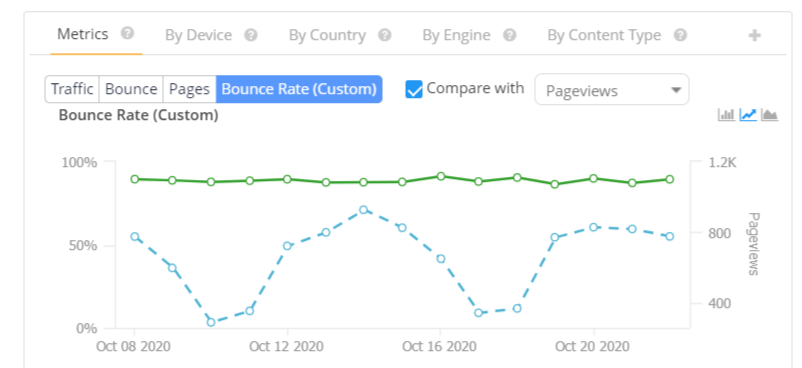
(Comparing bounce rate with page views in the seoClarity platform.)
Additionally, the ability to segment out reports with a variety of filters like page tags, content types, device type, and more allows you to get granular in your analysis and see which next steps need to be taken.
How to Improve Your Bounce Rate
We covered a number of different reasons why people bounce from a page, and now comes the time to cover the solutions. All of them have to do with enhancing the user experience, although in different capacities.
Take a look:
#1. Offer engaging elements.
Once users land on your page, you want them to navigate down the funnel, and to do this you need to continuously keep them engaged.
Luckily, there are a variety of ways to create engaging elements.
Breadcrumbs
Add breadcrumbs to your site to allow users to know where in the site hierarchy they are, and give them a simple way to “zoom out” and access broader pages on your site — all with a simple click.
If a user lands on a specific product page from the SERP, for example, and decides that the product isn’t what they want, breadcrumbs make it easier for them to explore other categories on your site rather than bounce back to the SERP for other options.

(Breadcrumbs show a user where in the site hierarchy they landed.)
People Also Bought
Ecommerce sites can benefit from adding a “People Also Bought” or “People Also Viewed” section to their product pages. Not only does this offer additional value to the users, it also entices them to click.
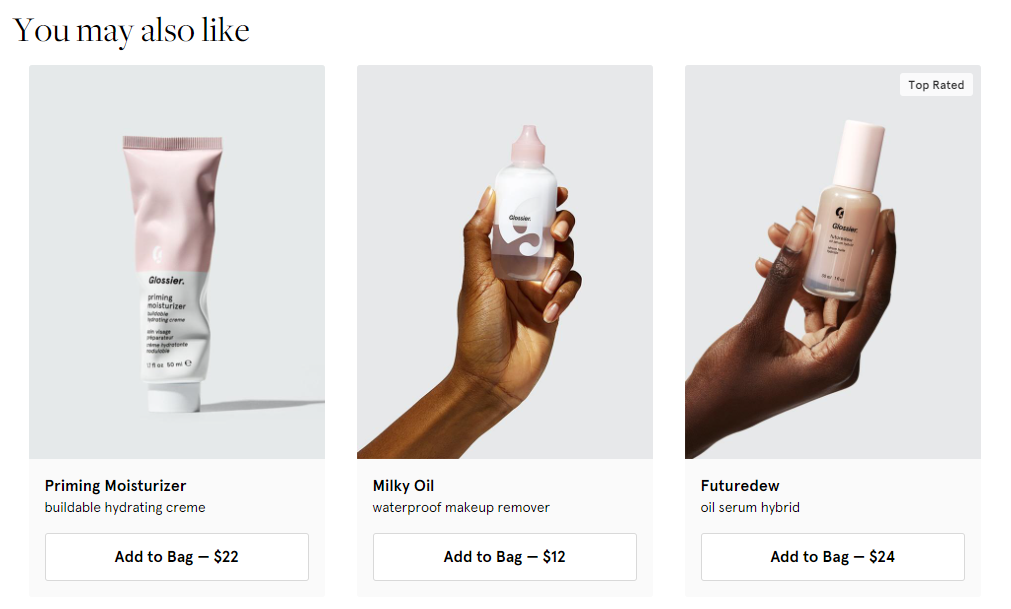
(Help users discover related products, and earn their click.)
Strategic Internal Linking Structure
A solid internal linking strategy can ensure that your related pages are grouped into their appropriate topic cluster, but it also leads the users down the path to further pages on your site.
For a blog, this can be in the form of further resources or additional readings, as we see here.
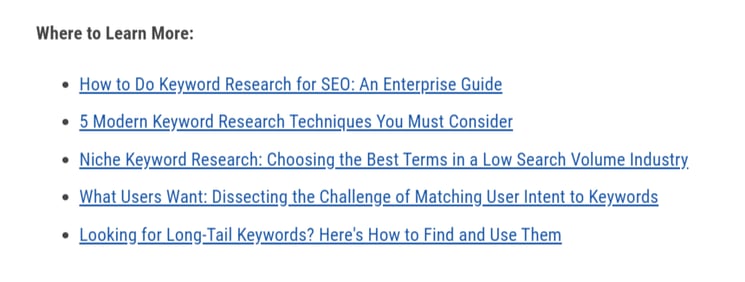
(Internal links offer value to further content and help to generate a click to another page.)
Create Engaging Content
You’re probably aware by now that content is at the heart of SEO. Our marketing team put together a list of 8 tricks to create engaging content, which includes things like supplemental video, a key points section, and more.
#2. Address the right user intent.
As we discussed, the way you present your content in an effort to match the correct user intent is as important as the content itself. A blog post is ideal for informational intent queries, while category and product pages are necessary to properly address a transactional intent.
#3. Keep critical elements above the fold.
Don’t make users hunt to find the information they’re looking for. They’re attention span isn’t that long, and they will bounce if they can’t get an answer to their query.
By showing critical elements above the fold, you prove to the user that you have the information they need, and they’ll be more inclined to stay and explore.
#4. Improve page speed.
Since an internet user waits for no one, your page needs to be ready for their arrival. Use a page speed testing tool to gauge your page speed performance, and optimize any necessary elements to increase your site speed.
Remember, even a seconds-long delay results in an increased bounce rate.
#5. Avoid pop-ups and distracting ads.
Elements that cause chaos and confusion should be avoided. These include pop-up windows, advertisements, and as mentioned previously, auto-play videos.
You can offer these content types on your page, but add them in a way that they’re not the center of attention. If additional elements are the main focus and not your actual content, you haven’t succeeded at your job.
#6. Have a mobile-friendly site.
Mobile devices allow users to access content anytime, anywhere. That’s why it’s crucial to optimize for mobile. If you only focus on desktop, you lose a large number of the visitors that come to your site.
Look at the below mobile site:
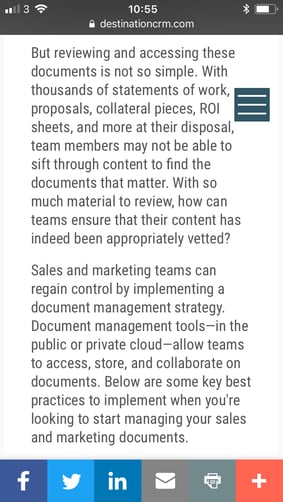
The content is readable, but it still looks cramped. When you optimize for mobile, you need to take into account the user’s mobile experience.
Having said that, this page is much better optimized for mobile:
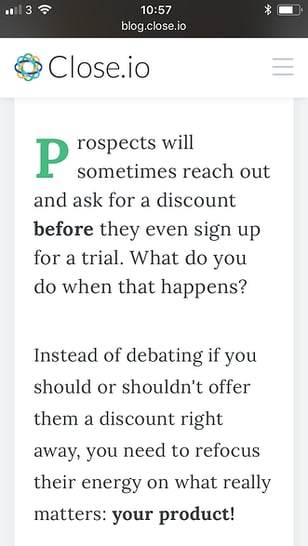
#7. Target your relevant audience.
In order to keep your audience engaged on your site to avoid a bounce, you need to make sure you target your relevant audience in the first place.
If the people who land on your site aren’t the ones you want to be engaging with your content and brand, they’re going to bounce.
#8. Avoid broken links.
Monitor your web pages to catch any broken links that would send users straight back to the SERPs. If you do have a 404 page, create one that is useful.
For example, you can direct users to your homepage, or include a CTA. This way, even though there is a technical error, you rectify the situation by providing some sort of value (and by persuading the users to not bounce).
#9. Create an attractive website.
Users are used to high-quality, dynamic web pages with a thoughtful combination of text, images, video, and other visual elements.
If your website looks outdated — plain text, no white space, etc. — and more reminiscent of an early-2000s site, users may be inclined to bounce. Even if your page offers great information that answers the query, this can be meaningless if the users have a negative reaction to the layout and style of your page right off the bat.
Conclusion
While there are a lot of implications stemming from your bounce rate, it’s certainly not the end-all and be-all of SEO. In some cases, users may have derived great value from your site, even though the bounce rate is high.
Still, it’s not a metric that should be entirely thrown aside. We’ve covered 9 different ways to improve your bounce rate — do you have any other tactics? Let us know in the comments below.




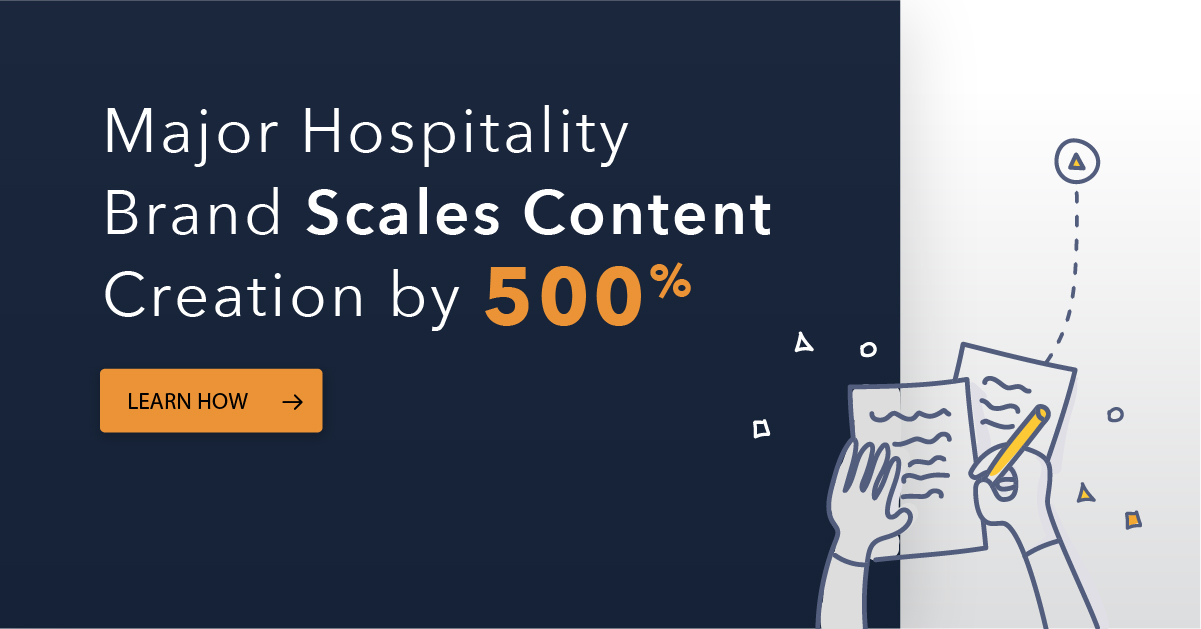
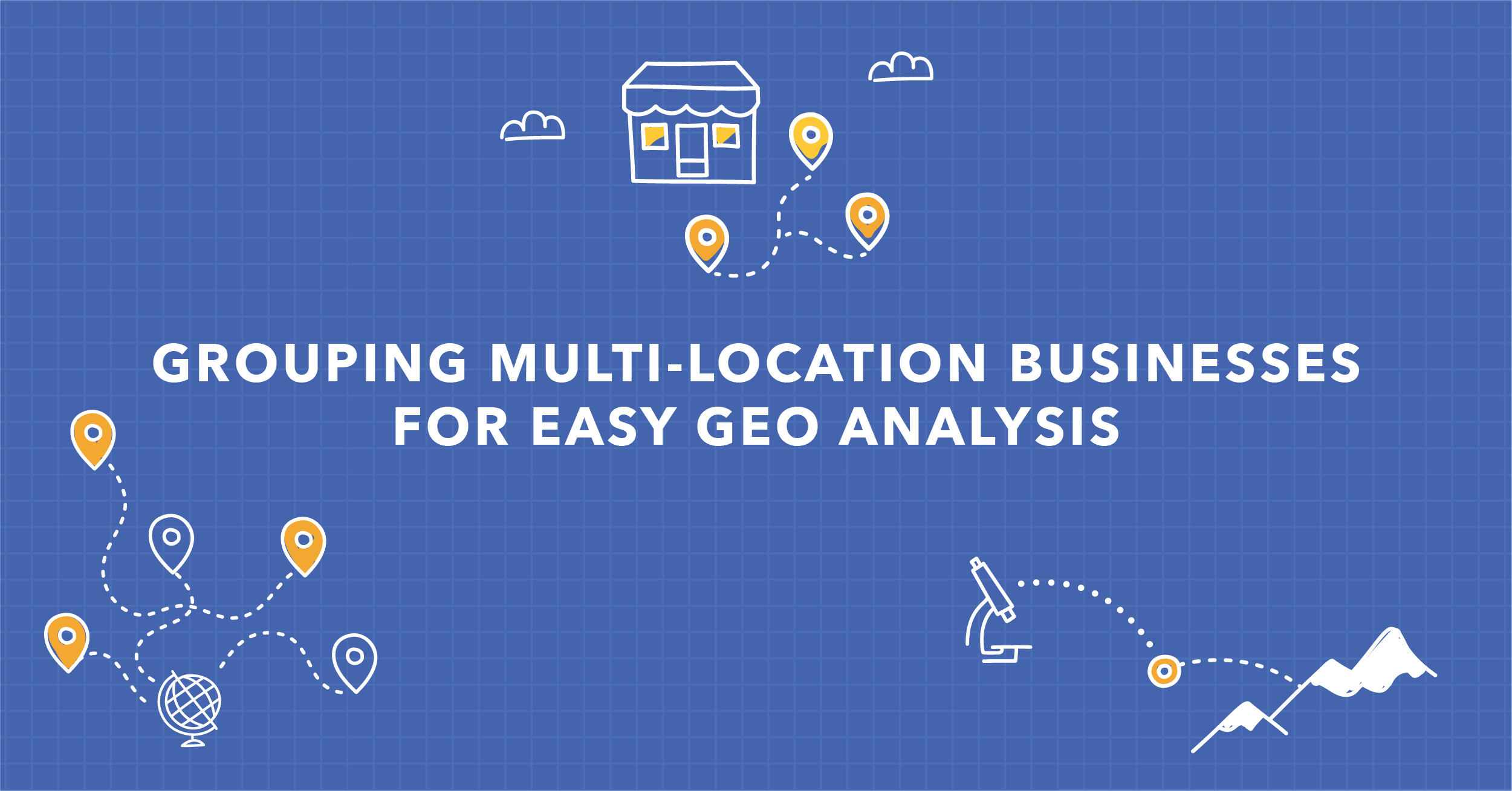

Comments
Currently, there are no comments. Be the first to post one!